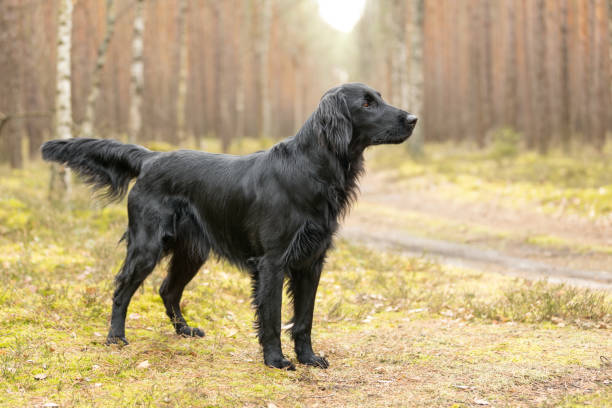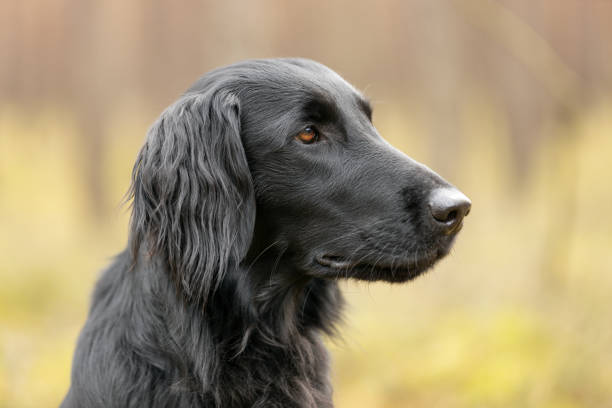Flat-coated Retriever

Breed History:
The Flat-Coated Retriever originated in 19th-century England as a versatile gundog developed for retrieving game on both land and water. Bred from a mix of breeds—including the now-extinct St. John’s Water Dog, Collies, and Setters—it was designed to be a dependable, tireless working companion. Its soft mouth, intelligence, and enthusiasm for water made it a favourite among sportsmen.
The breed reached peak popularity in the early 1900s, often considered the "gentleman's gundog." However, its numbers declined with the rise of the Labrador and Golden Retrievers. Despite its rarity today, the Flat-Coated Retriever remains cherished for its cheerful nature and strong retrieving instincts, making it both a capable working dog and a loving family pet.
Considering adopting a Retriever? Check out our page "How to look after a Retriever" detailing what to consider before adopting and our recommended products.
|
Gender |
Height |
Weight |
|
Male |
58–61 cm |
27–32 kg |
|
Female |
56–58 cm |
25–29 kg |
Size – Medium to Large
Life Expectancy: 8–10 years

Breed Appearance:
The Flat-Coated Retriever is known for its sleek, glossy coat and joyful expression. It has a long, elegant head with dark, almond-shaped eyes that radiate warmth and intelligence. The ears are pendant-shaped and lie flat against the head, adding to its refined appearance. Its long, feathered tail is typically carried level with the back, wagging frequently.
The breed’s signature coat is dense, flat-lying, and water-resistant, typically solid black or liver in colour. The feathering on the legs, chest, and tail adds to its elegance. With a balanced, athletic build, the Flat-Coated Retriever moves with a smooth, ground-covering gait that reflects both grace and power.
Breed Type – Family/Retrieving:
The Flat-Coated Retriever is known as the "Peter Pan" of the dog world due to its prolonged puppy-like demeanour. Playful, affectionate, and endlessly optimistic, this breed thrives on companionship and is eager to be involved in every aspect of family life. It is an ideal fit for active households that can provide time, interaction, and activity.
Though bred as a gundog, it is also a natural therapy and assistance dog, thanks to its gentle and friendly disposition. It is typically good with children and other pets, though its exuberance can be overwhelming without proper training. Flat-Coats do not make good guard dogs—they greet strangers with a wagging tail rather than suspicion.

Training:
Intelligent and eager to please, the Flat-Coated Retriever responds well to positive reinforcement training. Their cheerful temperament and natural curiosity make them quick learners, though their playful and easily distracted nature can pose challenges during training sessions. Early obedience and socialisation are important to instil good manners.
Because they thrive on mental engagement, training should be varied and fun to keep their interest. These dogs excel in advanced obedience, agility, scent work, and retrieving tasks. Harsh training methods should be avoided; instead, reward-based approaches using treats and praise yield the best results for this sensitive, people-oriented breed.
Health & Care:
The Flat-Coated Retriever is generally healthy and active but is unfortunately prone to certain serious health concerns, most notably cancer, including hemangiosarcoma and malignant histiocytosis, which significantly contribute to its shorter lifespan. Other health issues may include hip dysplasia, patellar luxation, and gastric torsion (bloat).
Routine veterinary care, a healthy diet, and regular exercise are essential for maintaining their well-being. Regular health screenings, especially for cancer, are recommended for early detection. Although their coat is relatively easy to manage, grooming plays a key role in overall skin and coat health, as does parasite prevention in active outdoor dogs.

Living Conditions:
Flat-Coated Retrievers do best in homes where they can be active and involved. They are not suited to being left alone for extended periods, as they crave companionship and stimulation. While they can adapt to apartment life with sufficient exercise, they thrive in homes with yards or access to parks and trails.
This breed does best with families who enjoy an active lifestyle, as it needs both physical activity and mental stimulation. Boredom or isolation can lead to undesirable behaviours like chewing, barking, or digging. Daily interaction, playtime, and training sessions are key to keeping this breed well-balanced and content.
Exercise:
The Flat-Coated Retriever is a high-energy breed that requires substantial daily exercise to stay healthy and happy. At least 1.5 to 2 hours of activity per day is ideal, which can include brisk walks, play sessions, swimming, or off-leash runs in safe areas. These dogs possess excellent stamina and enjoy working or playing for extended periods.
Mental stimulation is just as important—engage them with puzzle toys, scent games, or fetch. Their retrieving instincts make fetch a natural favourite. Without adequate physical and mental outlets, Flat-Coats can become restless and mischievous. Regular engagement helps to channel their boundless energy into positive behaviour.
Grooming:
The Flat-Coated Retriever’s dense, glossy coat is relatively easy to maintain with regular care. Brushing 2–3 times per week helps to prevent tangling and reduce shedding, especially during seasonal changes. Special attention should be paid to the feathered areas, which can trap debris and mat.
Bathing every 6–8 weeks or as needed keeps the coat shiny and clean. Regular ear checks and cleaning are crucial due to their floppy ears, which are prone to infection. Nail trimming and dental hygiene should also be part of the grooming routine. Overall, their grooming needs are moderate but consistent.

Advantages:
-
Outgoing, affectionate, and playful nature—great for families and children
-
Highly trainable and intelligent; excels in various canine sports
-
Loyal and friendly with people and other animals
-
Adaptable to different living environments when exercise needs are met
-
Natural retrieving and swimming instincts make them fun companions outdoors
-
Moderate grooming needs despite the feathered coat
Disadvantages:
-
High risk of certain cancers, contributing to a shorter-than-average lifespan
-
High energy levels require substantial daily exercise and engagement
-
Can become bored, anxious, or destructive if left alone or under-stimulated
-
Training can be challenging due to distractibility and prolonged puppy behaviour
-
Needs regular grooming to prevent mats and maintain coat health
-
Poor guard dog due to overly friendly disposition toward strangers

